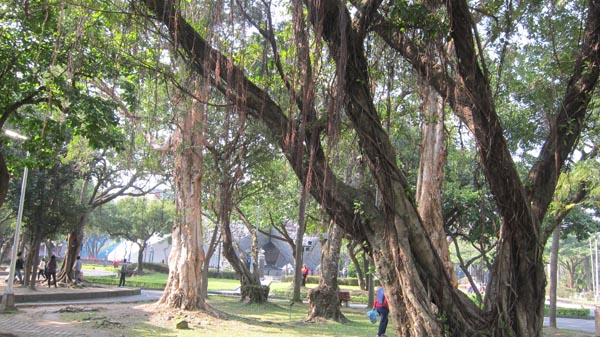| Taiwan Tales: 228 |

|

|

|
| Features | |
| Thursday, 02 June 2011 | |
|
To reach the 228 Memorial Peace Park from Taipei Main Station, leave the station at its southern exit. Walk past the dominating Shinkong Mitsukoshi department store and the stalls selling fried chicken feet to reach a T-junction. You will find yourself facing, across the road, the splendid National Taiwan Museum with its Palladian facade, framed by banyan trees on either side. The museum stands like a silent but imposing guard, in front of the entrance to the park. Go round to the back of the museum and you will find the park unfolding sedately like a series of tableaux. A couple sits on a bench that faces a large blue-green pond where ducks are paddling. In a small square of lawn scattered with long, lean trees, a man sits cross-legged in meditation. Groups of two and three men raise their legs, twist their bodies and punch the air in the controlled techniques of Tai Chi. A woman dressed in a pink dress teases her dog who wears a pullover in an exact matching pink. Gaggles of boys and girls hop and skip in the children’s play area. Just beyond this stands a Chinese pagoda surrounded by a moat, its fussy flying roof in sharp relief against the clean lines of skyscrapers in the background. ‘228’ refers to the date, 28 February, when a bloody explosion gripped the island and ripped it apart. The park is a living memorial to an event so terrible in the history of Taiwan that, for forty years, its people were not allowed to speak of it for fear that it would cause a haemorrhage that would overwhelm the country. On 27 February 1947, Lin Chiang-mai (林江邁), a widow, was selling cigarettes in a park in Taipei when two government agents started to harass her. The then Chinese Kuomintang government’s monopoly on the sale of tobacco and alcohol at the time meant that it was an offence for anyone else to sell the products. One agent hit Lin on the head with his pistol. Outraged onlookers surrounded the agents. An agent fired into the crowd, killing a bystander and, in the ensuing confusion, both agents escaped.
These twin incidents sparked a series of protests and riots across the island. The minority Mainland Chinese militia - most were still engaged in battle against Mao Tse Tung’s forces in China - laid into the Taiwanese and the Taiwanese vented their frustrations against the Mainlanders, whom they saw as despotic and corrupt, and no better than their previous rulers, the Japanese. Thousands on both sides were killed. A rattled Chen Yi met an ad hoc group calling themselves The Committee to Settle the Monopoly Bureau Incident. The Committee presented a set of demands, the first of which was that the government forces should hand over their weapons to specified authorities. Given that ordinary people were being shot at will, this did not seem unreasonable. But Chen Yi had secretly sent messages to Mainland China for military reinforcements. Chiang Kai-shek (蔣介石), co-founder and the all-powerful Commander-in-Chief of the Kuomintang, acceded to the request. On 8 March, the Mainlander militia attacked the Taiwanese with a force so savage that within a few months, tens of thousands of Taiwanese were killed, injured or missing. Over the next few months, many more thousands of Taiwanese were murdered or jailed. Martial law was declared and not lifted until 1987. In the centre of the park is the Peace Memorial, a huge abstract piece of sculpture in stern black metal. Rising awkwardly from its large squat base, a sword-like structure points skywards, as if accusing the heavens for failing to stem the atrocities. It stands opposite the Peace Memorial Museum, an attractive red-brick building designed by the Japanese and which had housed their first propaganda radio station in the 1930s. Among the thousands of files held in the museum is the most important document of all. The document went public only after a committee of scholars had pored over and agreed on the exact nuance and meaning of each word and each sentence. This details the events of 228 and implies that Chiang Kai-shek was responsible for the massacre. Although the Kuomintang government of the day has been held accountable for it, there has never been a person identified as being the one who had given the order to kill. This lack of accountability continues to be a festering sore in the country. Chiang, a compatriot of Sun Yat-sen (孫逸仙) - known as the founding father of Chinese democracy - is hugely admired in Taiwan and abroad as the architect of modern democratic Taiwan. But for the relatives of the victims of 228, he remains the man who had unleashed the Stalinesque purge of his own people. In the museum grounds lies the saddest testament to 228. Hanging on the walls of a wooden walkway entwined with climbing hibiscus is panel upon panel of head-and-shoulder photographs of mostly men and some women. Their silent eyes stare across the Peace Memorial, the blue-green pond, the men engaged in Tai Chi, the dancing dog and the skipping children, each face a haunting reminder of lives cruelly denied. Who were they? What were they doing on the day they were gunned down, or dragged away and later executed? Were they political activists agitating for change, hotheads out for excitement, relatives of officials indiscriminately fingered, or simply people out on their way to work? Next to the wooden walkway is a tall red brick wall. It is entirely covered with a black metal mesh. Small strips of white sack-cloth are tied to the mesh. Each strip bears the name of a dead person. There are hundreds of these strips, a bizarre bunting of white scattered across the red. They rise and flap each time the wind blows, a gentle chorus like a reprimand from beyond. On 28 February this year - as has happened every year since 2003 - the day was a public holiday, with open ceremonies held in all the major cities. President Ma Ying-jeou (馬英九) repeated an apology on behalf of the Kuomintang government and reasserted the government’s commitment to complete monetary compensation to families of the victims. Up and down the country, protests and re-enactments of the events of 228 were staged. None of this is enough for thousands of Taiwanese who continue to demand that the architect of the massacre be named. I sit on a rock hewn from granite across the Peace Memorial and eat my rolls of sushi. The couple on the bench, the woman and her dog in pink and the men practising Tai Chi are long gone. A woman cycles past me, her basket piled high with groceries. An elderly couple, hand in hand, stroll towards the museum. From behind me, I hear the laughter of friends sharing a picnic. The park - like all parks over the world - is an inviting oasis of calm. But in this park, the tranquility resonates with the screams of the dead. Words and pictures by Wah-Yin Rixon. Wah-Yin Rixon lives and works in Taiwan.
|
|






 The next day, on 28 February, thousands of protestors gathered outside Governor-general Chin Yi (陳儀)’s office, having found the Monopoly Bureau building locked and guarded. Guards fired at them, killing two and wounding several others.
The next day, on 28 February, thousands of protestors gathered outside Governor-general Chin Yi (陳儀)’s office, having found the Monopoly Bureau building locked and guarded. Guards fired at them, killing two and wounding several others.
